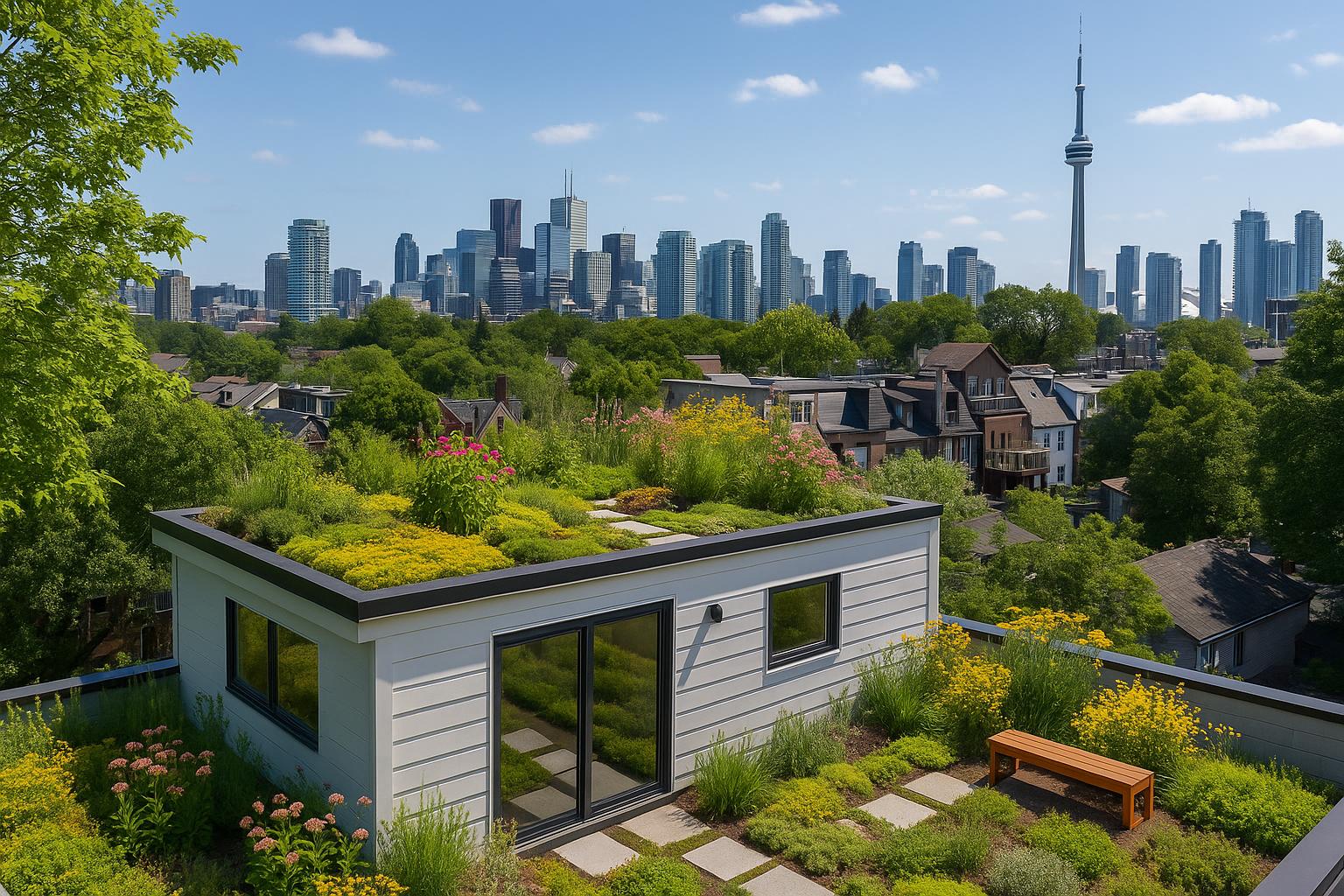
ADU Rooftop Gardens: Transforming Canadian Cities Through Urban Greening
Estimated reading time: 8 minutes
Key Takeaways
- Innovative Urban Greening: Transforming unused ADU rooftop spaces into vibrant gardens to improve urban sustainability.
- Environmental Impact: Rooftop gardens help mitigate heat islands, enhance air quality, and manage stormwater efficiently.
- Social & Economic Benefits: These gardens create aesthetic, community-building spaces that can boost property values and foster local food production.
- Compliance & Adaptation: Ensuring structural safety, adhering to local building codes, and selecting climate-adapted plants are essential for success.
Table of Contents
- Introduction: ADU Rooftop Gardens—A New Era in Urban Sustainability
- Overview of ADUs in Canadian Cities
- Benefits of Rooftop Gardens on ADUs
- Practical Considerations for Establishing Rooftop Gardens on ADUs
- Case Studies and Examples
- Contributions to Broader Sustainability Goals
- Conclusion: Key to Sustainable Canadian Cities
- Frequently Asked Questions
Introduction: ADU Rooftop Gardens—A New Era in Urban Sustainability
ADU rooftop gardens represent a cutting-edge solution by transforming otherwise unused rooftop spaces atop accessory dwelling units in Canadian cities. This innovative approach reclaims flat surfaces on garden suites, laneway homes, and detached backyard units, turning them into lush, functional gardens that bolster urban sustainability.
At the core of these gardens is the ability to address environmental challenges, such as:
- Small-scale food production – growing vegetables, herbs, and fruits;
- Mitigating urban heat islands – using natural cooling methods;
- Air quality improvement – absorbing pollutants and sequestering carbon.
As one study notes, ADU rooftop gardens are an emerging urban greening solution in Canadian cities that address key sustainability and livability challenges by reclaiming unused rooftops
[source].
Overview of ADUs in Canadian Cities
What Is an ADU?
An Accessory Dwelling Unit (ADU) is a self-contained housing unit built on the same lot as a primary residence. These units include:
- Detached backyard suites (garden suites)
- Basement apartments or secondary suites
- Converted garages or above-garage units
ADUs play a pivotal role in urban development and are gaining traction for their contribution to affordable housing and urban infill strategies. For more details, please visit St. Catharines ADU guidelines and Jasper Garden Suite Requirements. You can also find additional insights at ADU Start Guide.
Growing Popularity in Major Centres
Major Canadian cities such as Toronto, Vancouver, and Calgary are rapidly embracing ADUs:
- Toronto: Promotes laneway and garden suites to support urban density.
- Vancouver: A pioneer in laneway houses, streamlining permits for secondary dwellings.
- Calgary: Implements progressive zoning changes favoring ADU development.
Learn more about ADU-friendly neighbourhoods at ADU Friendly Neighbourhoods and urban infill initiatives at Urban Infill & Tiny Homes on ADUs.
Benefits of Rooftop Gardens on ADUs
Environmental Benefits: Rooftop Garden and Urban Greening
Rooftop gardens deliver significant environmental advantages, including:
- Urban Greening: Increasing vegetation and creating ecological corridors for pollinators and birds. Discover more on wildlife-friendly landscaping.
- Heat Island Mitigation: Reducing surface temperatures through natural cooling methods as explained in green roofs for tiny homes.
- Air Quality Improvement: Absorbing pollutants and sequestering carbon; details available at air quality in tiny homes.
- Stormwater Management: Slowing rainfall to ease the burden on urban drainage, as noted at urban ADU rainwater recycling.
Social & Economic Benefits
Beyond the environmental perks, ADU rooftop gardens also enhance urban livability:
- Aesthetic Improvement: Replacing grey, monotonous urban structures with visually appealing green spaces. More at small-space landscaping.
- Community Engagement: Fostering shared gardening projects that build social ties, as highlighted in community-led tiny home development.
- Mental Well-Being: Increased exposure to nature is linked to reduced stress and improved mood (read more).
- Economic Advantages: Energy savings from improved insulation and higher property values championed by sustainable design (investment benefits).
Practical Considerations for Establishing Rooftop Gardens on ADUs
Structural and Design Requirements
Before launching a rooftop garden project, ensure your ADU’s structure is capable of supporting the additional load. A professional engineering assessment is critical. Consider the following:
- Professional Engineering Assessment: Confirm that the roof can support soil, water, and plant systems (source).
- Green Roof Types:
- Extensive Green Roofs: Shallow soil layers (5–15 cm) ideal for low-maintenance plants like sedums.
- Intensive Green Roofs: Deeper soil profiles (15 cm+) that accommodate vegetables and shrubs, often requiring extra structural reinforcement.
Canadian Climate Adaptation
Designing gardens for the Canadian climate involves:
- Wind Exposure: Installing windbreaks or screens to manage strong gusts.
- Cold Tolerance: Selecting plants that thrive despite freezing temperatures.
- Water Management: Using automated irrigation and moisture sensors to optimize water usage (source).
Plant Selection and Maintenance
For a sustainable rooftop garden, choose plants that are well-adapted and require minimal upkeep. Recommended options include:
- Leafy Greens: Lettuce, spinach, and kale.
- Compact Vegetables: Tomatoes, peppers, and radishes suitable for container systems.
- Herbs: Chives, basil, and thyme for resilience under rooftop conditions.
- Native Species: Locally adapted grasses, flowers, or shrubs for lower maintenance.
Regular maintenance such as pest monitoring, soil fertility enhancement, and proper pruning is essential for the longevity of your garden (source).
Case Studies and Examples: Rooftop Gardens in Canadian Cities
Toronto & Vancouver: Leading the Way
Both Toronto and Vancouver have initiated programs to integrate green roofs into urban landscapes:
- Toronto: Incentivizes green roofs through development charge rebates and pilot projects (learn more).
- Vancouver: Early adopter of the laneway house concept, now extending similar strategies to rooftop gardens (source).
Calgary: MODA Rooftop Garden
A notable project in Calgary, the MODA Rooftop Garden, demonstrates communal green spaces that boost social interaction, food production, and climate resilience. More details can be found at Dezeen.
Jasper: Garden Suite Policies
In Jasper, flexible garden suite policies allow homeowners to creatively integrate green roofs that complement the local architectural style (source).
Contributions to Broader Sustainability Goals in Canadian Cities
Integrating ADU rooftop gardens is not just about beautification; it’s a strategic move towards enhanced urban sustainability:
- Carbon Reduction: Green roofs sequester CO2 and offset urban emissions (read more).
- Climate Resilience: Regulated rooftop temperatures and improved stormwater management help cities withstand climate variability (source).
- Urban Agriculture: By supporting local food production, these gardens increase self-sufficiency and reduce food miles (more info).
Conclusion: ADU Rooftop Gardens—Key to Sustainable Canadian Cities
Core Benefits Summarized:
- Environmental: From boosting biodiversity to mitigating heat islands and managing stormwater, these gardens play a vital role.
- Social: Rooftop gardens create communal spaces, alleviate urban stress, and inspire community engagement.
- Economic: Enhanced energy efficiency, increased property values, and opportunities for homegrown produce provide tangible financial benefits.
For homeowners, architects, and city planners, careful review of local guidelines (Canadian ADU Regulations Guide), engaging with experienced structural engineers, and choosing climate-resilient plants are the next steps toward transforming urban spaces—one rooftop at a time.
Explore more on the topic at:
Frequently Asked Questions
What exactly is an ADU rooftop garden?
An ADU rooftop garden is a green space established on the flat roof of an Accessory Dwelling Unit. It transforms unused space into an area for food production, leisure, and environmental benefits while complying with local building and safety regulations.
How can I ensure my rooftop garden is structurally safe?
Safety starts with a comprehensive engineering assessment. Have a qualified professional evaluate your roof’s load-bearing capacity and review local building codes before installation.
Are there challenges with maintaining these rooftop gardens in Canadian climates?
Yes, the harsh winters and variable weather call for careful plant selection, robust water management systems, and regular maintenance to keep your garden thriving year-round.
Where can I find guidelines and permits for building an ADU with a rooftop garden?
You can find detailed guidelines and permit information through local municipal websites and resources such as the Canadian ADU Regulations Guide.

Leave a Reply